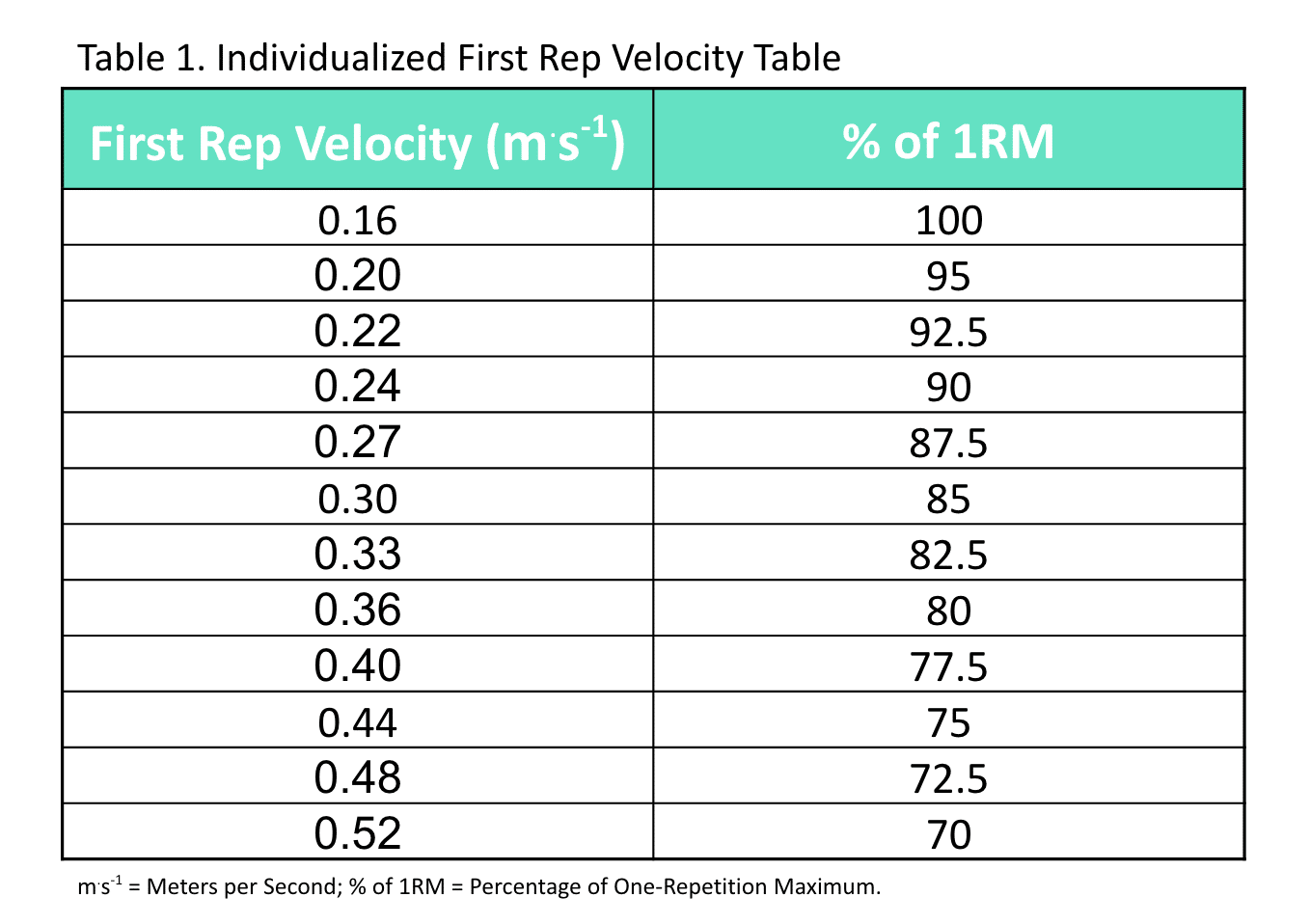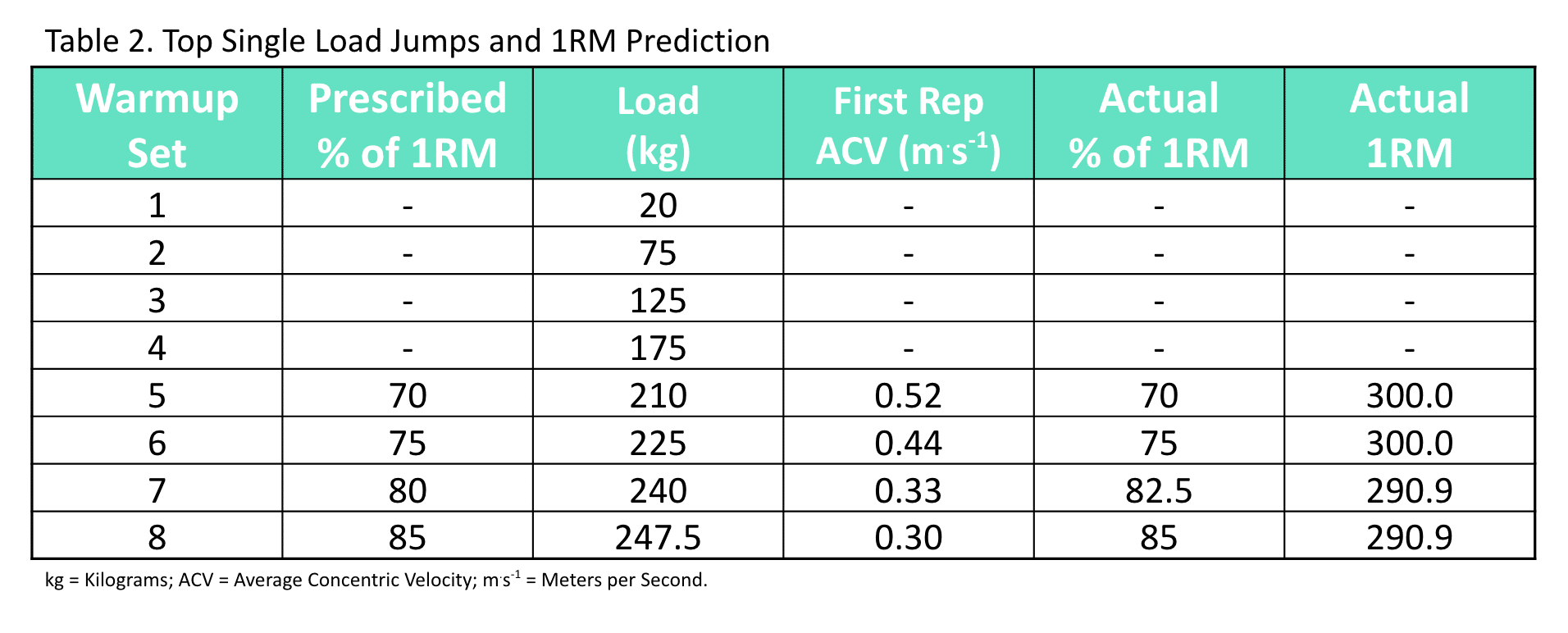1RM is one of the most important metrics – perhaps even the most important metric – that all strength athletes must monitor. Join me as I pull back the curtain and provide a sneak peek into several novel strategies addressing how to work up to a top single, predict 1RM, and progress 1RM using velocity so that you can appropriately monitor 1RM in the short- and long-term.
Key Points
- Individualized linear regression and polynomial regression equations can over-predict 1RM substantially
- Employing an Individualized First Rep Velocity Table is an effective method to make precise load jumps while working up to a top single and to accurately predict 1RM
- Employing an Individualized First Rep Velocity Table is an advantageous method to progress and monitor estimated 1RM in the short- and long-term
“I constantly “over-shoot” my top single!” Perhaps this is a consistent statement every time you work up to a top single. Perhaps you gave both the linear regression equation and the polynomial regression equation a shot that I addressed in my article titled INDIVIDUALIZED LOAD-VELOCITY PROFILES: APPLICATION CONSIDERATIONS FOR INCREASING PREDICTION ACCURACY and they still substantially over-estimated your 1RM. For this reason, what I typically suggest is to use what I’ve termed an Individualized First Rep Velocity Table in order to cross-reference your individualized first rep velocity with your individualized percentage of 1RM for appropriate 1RM monitoring. In this article, I’ll use the Individualized First Rep Velocity Table (Table 1) to address how to optimally work up to a top single and precisely predict 1RM, ensure that the prescribed percentage of 1RM is being used for the working sets during a training session, and two 1RM progression methods for monitoring 1RM.

Top Single Load Jumps and 1RM Prediction
I’m a huge proponent of performing singles to commence nearly every session; whether it be a top single at say an 8 RPE during a “strength-focused” session or an over-warm single at say a 5 RPE during a “hypertrophy-focused” session. How do I suggest working up to a top single in order to ensure that it is not “overshot” or “undershot”? One of the best methods that I’ve created to accurately hit that top single at the prescribed RPE (or percentage of 1RM) is to use what I’ve termed an Individualized First Rep Velocity Table and cross-reference the individualized first rep velocities with individualized percentages of 1RM during each warmup set starting at ~70% of an athlete’s typical 1RM in order to make precise load jumps and accurately predict 1RM.
For example, let’s say an athlete is working up to a top single at a 6 RPE, which corresponds to 85% of their 1RM, and their typical 1RM is 300 kilos (Table 2). Furthermore, let’s say that the individualized first rep velocities during all of the warmup sets starting at ~70% of 1RM correspond to individualized percentages of 1RM that provides an actual 1RM of 300 kilos until the final warmup which is prescribed as 80% of the athlete’s typical 1RM or 240 kilos. As illustrated in Table 1, the individualized first rep velocity on the final warmup of 240 kilos is 0.33 m.s-1, which indicates that 240 kilos was actually performed at 82.5% of 1RM (not 80% of 1RM). Therefore, 240 kilos is divided by 0.825 in order to determine the actual 1RM on the final warmup, which is 290.9 kilos. Consequently, rather than prescribing 85% of 300 kilos (the typical 1RM) for the top single at a 6 RPE, 85% of 290.9 kilos (the actual 1RM based on the final warmup) which equates to 247.5 kilos is prescribed for the top single at a 6 RPE. Finally, based on the individualized first rep velocity of the top single, the actual percentage of 1RM on the bar can be determined and the actual sessional 1RM can be determined. Specifically, the individualized first rep velocity on the top single is 0.30 m.s-1, which indicates that 247.5 kilos was indeed performed at 85% of 1RM and that the actual 1RM for the session is 290.9 kilos.
It is important to note that sometimes the individualized first rep velocity at a given load may be slower than normal simply due to a technical error in the lift; therefore, you can also “over-ride” the objective individualized first rep velocity, and you can still perform the top single at the initial planned load if you are confident that you can nail it at the prescribed RPE (or percentage of 1RM). Also, if you just know that you have it in you on that particular day to hit the top single at the prescribed RPE (or percentage of 1RM) despite the individualized first rep velocity on the final warmup being slightly slower than normal you can go ahead and take the top single at the initial planned load. In addition, you can also set specific criteria for altering the load jumps. For example, you can stipulate that if the 2nd final warmup and the final warmup are both performed slower than normal, you appropriately adjust the load for the top single. However, if only one of the two final warmups are performed slower than normal, you don’t adjust the load for the top single. Finally, I like to use this method starting at ~70% of an athlete’s typical 1RM, simply because it can become excessive to adjust the load during every warmup set below ~70% of an athlete’s typical 1RM. Moreover, I like to prescribe and standardize the absolute loads below ~70% of 1RM to ensure that every single warmup set is performed with the exact same focus and as a monitoring tool by comparing the individualized first rep velocities at each absolute load to the previous sessions.

Single Repetition at Session’s Prescribed Percentage of 1RM
Performing a single repetition at the session’s prescribed percentage of the typical 1RM is a quick method to ensure that the percentage of 1RM used during the working sets of the session are representative of the sessional 1RM. This method is simple: perform a single repetition at the prescribed percentage of the typical 1RM for the working sets of the session, and use what I’ve termed an Individualized First Rep Velocity Table to cross-reference the individualized first rep velocity with individualized percentage of 1RM to determine what the actual percentage of 1RM on the bar was and in order to appropriately adjust the load for the working sets so that it is representative of the actual sessional 1RM.
For example, let’s use a basic example and say that the session’s prescription is 5 sets of 3 repetitions at 85% of 1RM (Table 3). First, a single repetition at 85% of the typical 1RM is performed. If the typical 1RM is 300 kilos, a single repetition at 255 kilos is performed. After 255 kilos is performed for a single repetition, the individualized first rep velocity is cross-referenced with the individualized percentage of 1RM. As illustrated in Table 2, if the individualized first rep velocity is 0.30 m.s-1 (Scenario 1 in Table 3), this would indicate that 255 kilos was indeed performed at 85% of 1RM. Therefore, 255 kilos would be used for the 5 sets of 3 repetitions. However, if the individualized first rep velocity is 0.27 m.s-1 (Scenario 2 in Table 3), this would indicate that 255 kilos was actually performed at 87.5% of 1RM. Therefore, 255 kilos is divided by 0.875 in order to determine the actual 1RM for the session, which is 291.4 kilos. Consequently, rather than prescribing 85% of 300 kilos (the typical 1RM) for the 5 sets of 3 repetitions, 85% of 291.4 kilos (the actual 1RM based on the single repetition to start the session) which equates to 247.5 kilos would be prescribed for the 5 sets of 3 repetitions.

Maintain Top Single Load Every Session and Track Velocity
Typically, a single repetition at a specific RPE is prescribed over the course of a training block. For example, a top single at an 8 RPE may be prescribed for every “strength-focused” session. However, you can simply prescribe the same load every session and track the individualized first rep velocity in order to progress and monitor estimated 1RM (e1RM). This top single 1RM progression method is particularly useful for athletes that have a tendency to work up to a maximal top single (i.e. 9.5 – 10 RPE) despite the protocol prescribing a submaximal top single (i.e. 7 – 8 RPE), or athlete’s that have a tendency to commonly “undershoot” or “overshoot” the RPE substantially on their top singles. This method is also particularly useful during “hypertrophy-focused” sessions or periods of training when progressing top singles aggressively is not an absolute necessity.
For example, rather than prescribing a single repetition at an 8 RPE, you can prescribe a single repetition at a load that typically corresponds to an 8 RPE, and maintain that load for every session until that load elicits an individualized first rep velocity corresponding to a 6 RPE. Once that load elicits an individualized first rep velocity corresponding to a 6 RPE, you can increase the load to what would typically correspond to an 8 RPE based on the new e1RM for the next session and repeat the progression. To provide an example, if a single repetition at an 8 RPE corresponds to 90% of 1RM for a particular athlete and the athlete’s typical 1RM is 300 kilos, then 270 kilos may be prescribed as the top single for every “strength-focused” session (Table 4). As illustrated, 270 kilos corresponded to an 8, 7.5, 7, 6.5, and 6 RPE (85% of 1RM) based on the individualized first rep velocity during session’s 1, 2, 3, 4, and 5; respectively. Therefore, during session 6, the athlete progressed to 280 kilos. Why did the athlete progress to 280 kilos and not 285 kilos (90% of the e1RM (317.6 kilos) from session 5)? Progressing from 270 kilos to 285 kilos is an excessive load increase, which may be appropriate for some athletes but may be inappropriate for other athletes. Collectively, the coach and the athlete can prescribe the next appropriate incremental load to repeat the progression.

Top Single at Capped RPE and Capped Load
This particular method of 1RM progression is similar to the previous method; however, rather than simply prescribing a specific load and tracking the individualized first rep velocity over the course of a training block, this method caps the top single during each training session at a specific RPE (corresponding to an individualized first rep velocity) or a specific load – whichever comes first in the training session. Furthermore, once the prescribed load elicits an individualized first rep velocity corresponding to a particular RPE value below the capped RPE for a particular number of consecutive sessions, you can progress to the next incremental load and repeat the progression. This method ensures that the athlete is not working up to a higher RPE than desired during sessions in which performance is low by also providing an RPE cap rather than an absolute load that they must work up to. Similar to the previous method, this method is also particularly useful during “hypertrophy-focused” sessions or periods of training when progressing top singles aggressively is not an absolute necessity.
For example, you can prescribe a single repetition at a 6 RPE or a load that typically corresponds to a 6 RPE (whichever comes first in the training session), and progress to the next incremental load once you are able to perform the capped load for 2 consecutive sessions at less than a 6 RPE. To provide an example, if a single repetition at a 6 RPE corresponds to 85% of 1RM for a particular athlete and the athlete’s typical 1RM is 300 kilos, then the top single may be prescribed as a 6 RPE/85% of 1RM or 255 kilos (a single at what would typically be a 6 RPE/85% of 1RM on a good day) – whichever comes first in the training session (Table 5). As illustrated, during session 1 the athlete only worked up to 250 kilos (not 255 kilos), because 250 kilos elicited an individualized first rep velocity corresponding to a 6 RPE. Conversely, during session 4 the athlete worked up to 255 kilos at only a 5 RPE based on the individualized first rep velocity (not a 6 RPE based on the individualized first rep velocity) because 255 kilos was the capped load. The athlete performed 255 kilos for 2 consecutive sessions at less than a 6 RPE based on the individualized first rep velocity on session 4 and session 5. Therefore, during session 6, the athlete progressed to 262.5 kilos (85% of the e1RM (309.1 kilos) from session 5).

Conclusion
This article used what I’ve termed an Individualized First Rep Velocity Table to address how to optimally work up to a top single and precisely predict 1RM, how to ensure that the prescribed percentage of 1RM is being used for the working sets during a training session, and two methods of progressing 1RM over the course of a training block for appropriate 1RM monitoring. In addition, remember that this article only provided a brief sneak peek into 1RM prediction and progression strategies and that there are endless other 1RM monitoring strategies. Finally, keep in mind that the 1RM monitoring strategies outlined in this article can and should be used in conjunction with the other autoregulation strategies that I’ve discussed in my other articles to appropriately prescribe load and autoregulate volume within a training session and across a training block.
If you are looking to reach your fullest potencial as an athlete and you want to learn more about sport science, VBT training and how to improve your workout routine, we have lots of articles that can help you achieve your goal. If you have any questions, don’t hesitate to ask! Leave a comment or contact us here.
Key Takeaways
-
Employ an Individualized First Rep Velocity Table to make precise load jumps while working up to a top single and to accurately predict 1RM during a training session
-
Employ an Individualized First Rep Velocity Table to ensure that the prescribed percentage of 1RM is being used for the working sets during a training session
-
Employ an Individualized First Rep Velocity Table to systematically progress and appropriately monitor estimated 1RM across a training block











